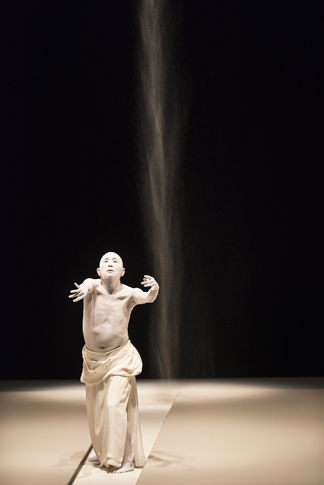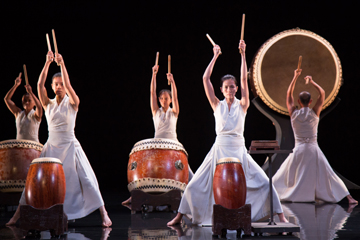Dance: Two Asian Troupes: Sankai Juko and U-Theater
By Dawn Lille
ART TIMES Jan/Feb 2016 online
 Ushio-Amagatsu Umusuna photo: Jack-Vartoogian. |
Within a period of a few weeks last fall two companies appeared at the Brooklyn Academy of Music: Sankai Juku, originally from Tokyo and now based in Paris as well, and U-Theater, from Taiwan. The former dates from 1975 and is well known here. Its butoh technique had great influence on American modern dance of the 8o’s. The latter was founded in1988 by Liu Ruo-yu, an MA theater graduate from New York University, who was influenced by the Polish director Jerzy Grotowsky and returned to her native country to found U-Theater.
Both groups brought an Asian sensibility and meditative approach via visuals, lighting and sound, in addition to movement. There were similarities in both polished performances, but also interesting differences.
Sankai Juku, a company of eight male butoh dancers, presented Umusuna: Memories Before History. It was conceived, directed and choreographed by Ushio Amagatsu, who founded the company after training in both classical and modern dance. Butoh, which emerged in Japan in 1959, was a reaction to the events and the aftermath of World War II, particularly Hiroshima. It was grotesque, erotic, rebellious and, in the case of Sankai Juku, concerned with a return to the primal. The dancers, with their shaven heads and white facial and body paint, create another world on stage, projecting confidence in their venue and stance.
Umusuna, an ancient Japanese word that means roughly “memory before history,” is from the root ubusu, meaning “birth,” but it can also mean “everything and nothing, existence and nothingness.” Na means “soil or land.” There were seven parts to the dance that evoked birth, water, wind, forests, erosion and, finally, ubusu. All seemed to deal with the concept of life and time passing.
The different sections used the dancers, including Amagatsu, in various combinations. The movement was incremental, with arms bent at the elbow and hands claw- like. The bare heads and torsos of the performers, who wore long white wraps, evoked a sense of ancient spirits. When they opened their mouths in silent screams they recalled the anguish in so many of their original performances.
The set had two large squares on the floor separated by a space of about two feet. They seemed at first to be slate gray but then changed color due to the lighting that reflected on the sand covering them. The backdrop was two square hanging cloths, also separated. In this space was a constant flow of sand that looked like water at times and changed with the lights.
In the program notes were quotes from an article by Amagatsu in which he talks about the two plates needed for balance in existence. One is the unique characteristic of a culture and the other belongs to all humankind. It is possible that the two scales, one on each side of the stage, with their opalescent round discs and lights, represented this. They kept rising and falling, not necessarily in tandem.
The lights, both in color and intensity, created a visual that, in focusing on different parts of the set and sand, was often as interesting as the movement, which, for the most part, was sustained. The music went from vague soothing sounds to organ swells to an occasional vigorous bell, but was largely creative background.
 Beyond-Time photo: Max-Gordon-1 |
Walking, spinning and bursts of scooting were the main movements that carved intricate patterns on the stage. The dancers also created smaller ones in the sand itself, using their hands to scoop it up. There were periods of complete stillness.
Of the seven sections, the last, which projected a sense of peace or acceptance, was extremely rich visually and the music took a positive turn. The dancers resembled Greek statues, as they had in the opening. They seemed to have succeeded in defying gravity. Maybe they were implying that the chaos of the world can be coerced into a kind of stability.
Beyond Time by the U-Theater was, according to the program note, meant to explore the relationship between man and the universe. The “U” in their name relates to the Chinese word for excellence, which they obviously try to achieve by training in a blend of meditation, drumming, long walks and martial arts. This does mesh into a kind of dance technique. The music director and choreographer was the Malaysian master drummer Huang Chih-chun.
The work is a “journey” in six scenes accomplished by using digital technology to produce natural phenomena such as rain, air, rivers and the moon in eclipse. Using drums of all sizes, the company is trained in Taiko, a type of Japanese drumming with antecedents in China and Korea that was used to ward off evil spirits in temples.
The strong unison movements of the fifteen male and female dancers involved spinning reminiscent of the whirling dervishes. Often the moving dancers carried their drums, using their bodies to produce sound. In one scene that was mostly drumming they were dressed in black (at other times in white) and it was difficult to distinguish females from males. Sometimes the men were bare chested and all the performers wore flowing pants.
The movement and philosophy of U-Theater is also inspired by George Gurdjieff, a European who spent many years in the East and was interested in self-discovery via the body and ancient religious dances.
The piece began with dancers twirling on a floor lit by a diagonal light beam in font of a backdrop that opened in the center. This attempt to explore the mind via the body was aided not only by the constant drumming, but by video designs that were an art form in themselves. Hsu Yi-Chun, their designer, created a three dimensional stage that became four-dimensional using light, projections and a mirrored floor. The opening rain scene, the eclipse and the closing, with its fast moving dancers, who navigated ‘midst heavy metal gongs lowered from the ceiling, were most effective. But it all felt more like spectacle than dance.
Both of these trained and disciplined companies made use of visuals, lights and sound and both were concerned with the meditative aspect of Asian philosophy. Sankai Juku was more primal and more concentrated. Periods of stillness could lead the viewer to inner thoughts and space, although one had to allow this to happen. U-Theater was more active and noisy, but the drumming, wonderful as it was, did not lead to inner calm. It was most successful in the opening and closing scenes and the eclipse. They induced more active thinking, Sankai Juku more quiet contemplation. To this viewer the latter was preferable, but both opened vistas.
dawnlille@aol.com
